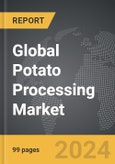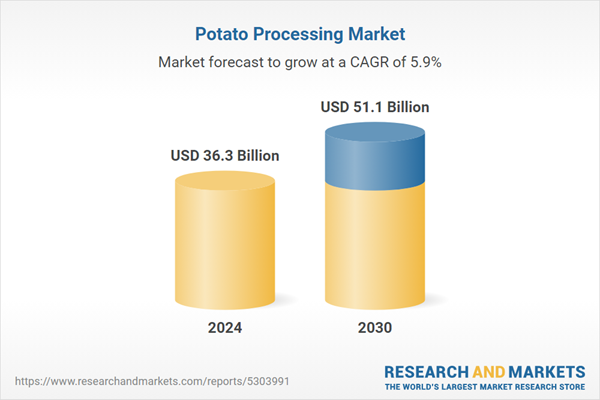The global market for Potato Processing was valued at US$36.3 Billion in 2024 and is projected to reach US$51.1 Billion by 2030, growing at a CAGR of 5.9% from 2024 to 2030. This comprehensive report provides an in-depth analysis of market trends, drivers, and forecasts, helping you make informed business decisions. The report includes the most recent global tariff developments and how they impact the Potato Processing market.
Segments: Type (Frozen, Chips & Snack Pellets, Dehydrated, Other Types); Distribution Channel (Foodservice, Retail); Application (Ready-to-Cook & Prepared Meals, Snacks, Other Applications).
Geographic Regions/Countries: World; United States; Canada; Japan; China; Europe (France; Germany; Italy; United Kingdom; Spain; Russia; and Rest of Europe); Asia-Pacific (Australia; India; South Korea; and Rest of Asia-Pacific); Latin America (Argentina; Brazil; Mexico; and Rest of Latin America); Middle East (Iran; Israel; Saudi Arabia; United Arab Emirates; and Rest of Middle East); and Africa.
The analysts continuously track trade developments worldwide, drawing insights from leading global economists and over 200 industry and policy institutions, including think tanks, trade organizations, and national economic advisory bodies. This intelligence is integrated into forecasting models to provide timely, data-driven analysis of emerging risks and opportunities.
Global Potato Processing Market - Key Trends & Drivers Summarized
What Is Driving the Increasing Demand for Processed Potato Products?
The global potato processing market has experienced significant growth due to rising consumer demand for convenience and ready-to-eat food products. Potatoes, being one of the most widely cultivated and consumed crops globally, are increasingly processed into various products such as frozen fries, chips, dehydrated potato flakes, granules, and starch. This shift towards processed potato products is largely driven by the growing urbanization and busy lifestyles of consumers, which favor quick and easy meal solutions. In developed economies, processed potatoes in the form of frozen French fries dominate the market, supported by the expansion of fast-food chains and quick-service restaurants (QSRs). The versatility of potatoes as an ingredient for snacks, meals, and foodservice applications has only added to their popularity, making them a staple in the processed food industry. Furthermore, developing economies are experiencing a surge in demand for processed potato products as their populations become more urbanized and disposable incomes rise, leading to increased consumption of packaged and convenience foods.How Are Technological Innovations Impacting Potato Processing Efficiency?
Technological advancements in potato processing have transformed the efficiency and quality of products. Modern processing techniques such as automated peeling, cutting, frying, and freezing systems have significantly reduced production times and improved yield, while also ensuring consistency in product quality. Innovations in dehydration technology have expanded the market for processed potato products like potato flakes and granules, which are used in a variety of food applications, from instant mashed potatoes to baked goods and snacks. These products benefit from extended shelf life, making them highly appealing for both consumers and food manufacturers. Furthermore, advancements in packaging technology, including modified atmosphere packaging (MAP), have enhanced the shelf life and freshness of processed potato products. The rise of smart manufacturing, incorporating data analytics and IoT, has enabled processors to optimize energy use, minimize waste, and improve product traceability, thereby contributing to overall operational efficiency and sustainability.What Are the Key Applications for Processed Potato Products?
Processed potato products have a wide array of applications across various sectors, further driving market growth. In the foodservice sector, frozen French fries, hash browns, and other frozen potato products are in high demand, particularly in fast-food chains and restaurants, where they are valued for their consistency, convenience, and long shelf life. Additionally, the snack industry heavily relies on processed potatoes in the form of chips and extruded potato-based snacks, which have global appeal due to their taste, texture, and variety of flavors. Beyond these traditional applications, processed potato starch is used extensively in the food industry as a thickening agent in soups, sauces, and processed meats, as well as in non-food sectors such as pharmaceuticals, textiles, and adhesives. The food processing industry also utilizes dehydrated potato products, including flakes and powders, in instant foods, such as instant mashed potatoes, soups, and bakery mixes, catering to the growing consumer demand for convenient meal solutions. The growing focus on health-conscious consumers has further diversified the application of processed potato products, with companies now offering low-fat, gluten-free, and organic options.Factors Driving the Growth of the Potato Processing Market
The growth in the potato processing market is driven by several factors, including changing consumer behavior, technological advancements, and shifts in food consumption trends. Firstly, the rising demand for convenience foods and ready-to-eat snacks continues to drive the expansion of the processed potato market, especially with the growing urban population. Additionally, the global expansion of fast-food chains and quick-service restaurants has significantly boosted the demand for frozen potato products, particularly in developing regions where the foodservice sector is rapidly evolving. Technological advancements in processing, such as automation, have enhanced production efficiency, reduced costs, and improved the quality and consistency of processed potato products, further driving their adoption. The increasing emphasis on sustainability and reducing food waste has also led to innovations in processing methods that maximize yield and extend product shelf life. Furthermore, the growing trend towards healthier eating has prompted manufacturers to develop low-fat, baked, and air-fried potato snacks, catering to health-conscious consumers. The expanding retail and e-commerce sectors, coupled with improved distribution channels, have made processed potato products more accessible to a broader consumer base, ensuring sustained market growth in the coming years.Report Scope
The report analyzes the Potato Processing market, presented in terms of units. The analysis covers the key segments and geographic regions outlined below.Segments: Type (Frozen, Chips & Snack Pellets, Dehydrated, Other Types); Distribution Channel (Foodservice, Retail); Application (Ready-to-Cook & Prepared Meals, Snacks, Other Applications).
Geographic Regions/Countries: World; United States; Canada; Japan; China; Europe (France; Germany; Italy; United Kingdom; Spain; Russia; and Rest of Europe); Asia-Pacific (Australia; India; South Korea; and Rest of Asia-Pacific); Latin America (Argentina; Brazil; Mexico; and Rest of Latin America); Middle East (Iran; Israel; Saudi Arabia; United Arab Emirates; and Rest of Middle East); and Africa.
Key Insights:
- Market Growth: Understand the significant growth trajectory of the Frozen segment, which is expected to reach US$25.3 Billion by 2030 with a CAGR of a 6.1%. The Chips & Snack Pellets segment is also set to grow at 6.2% CAGR over the analysis period.
- Regional Analysis: Gain insights into the U.S. market, valued at $9.4 Billion in 2024, and China, forecasted to grow at an impressive 9.2% CAGR to reach $12.0 Billion by 2030. Discover growth trends in other key regions, including Japan, Canada, Germany, and the Asia-Pacific.
Why You Should Buy This Report:
- Detailed Market Analysis: Access a thorough analysis of the Global Potato Processing Market, covering all major geographic regions and market segments.
- Competitive Insights: Get an overview of the competitive landscape, including the market presence of major players across different geographies.
- Future Trends and Drivers: Understand the key trends and drivers shaping the future of the Global Potato Processing Market.
- Actionable Insights: Benefit from actionable insights that can help you identify new revenue opportunities and make strategic business decisions.
Key Questions Answered:
- How is the Global Potato Processing Market expected to evolve by 2030?
- What are the main drivers and restraints affecting the market?
- Which market segments will grow the most over the forecast period?
- How will market shares for different regions and segments change by 2030?
- Who are the leading players in the market, and what are their prospects?
Report Features:
- Comprehensive Market Data: Independent analysis of annual sales and market forecasts in US$ Million from 2024 to 2030.
- In-Depth Regional Analysis: Detailed insights into key markets, including the U.S., China, Japan, Canada, Europe, Asia-Pacific, Latin America, Middle East, and Africa.
- Company Profiles: Coverage of players such as Agrana Beteiligungs-AG, Agristo NV, Aviko B.V., Burts Potato Chips Ltd., Farm Frites International B.V. and more.
- Complimentary Updates: Receive free report updates for one year to keep you informed of the latest market developments.
Some of the 53 companies featured in this Potato Processing market report include:
- Agrana Beteiligungs-AG
- Agristo NV
- Aviko B.V.
- Burts Potato Chips Ltd.
- Farm Frites International B.V.
- Idahoan Foods LLC
- Intersnack Group GmbH & Co. Kg
- J.R. Short Milling Company
- J.R. Simplot Company
- Lamb Weston Holdings, Inc.
- Leng-D’or
- Limagrain Céréales Ingrédients
- Mccain Foods Limited
- The Kraft Heinz Company
- The Little Potato Company Ltd.
Tariff Impact Analysis: Key Insights for 2025
Global tariff negotiations across 180+ countries are reshaping supply chains, costs, and competitiveness. This report reflects the latest developments as of April 2025 and incorporates forward-looking insights into the market outlook.The analysts continuously track trade developments worldwide, drawing insights from leading global economists and over 200 industry and policy institutions, including think tanks, trade organizations, and national economic advisory bodies. This intelligence is integrated into forecasting models to provide timely, data-driven analysis of emerging risks and opportunities.
What’s Included in This Edition:
- Tariff-adjusted market forecasts by region and segment
- Analysis of cost and supply chain implications by sourcing and trade exposure
- Strategic insights into geographic shifts
Buyers receive a free July 2025 update with:
- Finalized tariff impacts and new trade agreement effects
- Updated projections reflecting global sourcing and cost shifts
- Expanded country-specific coverage across the industry
Table of Contents
I. METHODOLOGYII. EXECUTIVE SUMMARY2. FOCUS ON SELECT PLAYERSIII. MARKET ANALYSISCANADAITALYSPAINRUSSIAREST OF EUROPESOUTH KOREAREST OF ASIA-PACIFICARGENTINABRAZILMEXICOREST OF LATIN AMERICAIRANISRAELSAUDI ARABIAUNITED ARAB EMIRATESREST OF MIDDLE EASTIV. COMPETITION
1. MARKET OVERVIEW
3. MARKET TRENDS & DRIVERS
4. GLOBAL MARKET PERSPECTIVE
UNITED STATES
JAPAN
CHINA
EUROPE
FRANCE
GERMANY
UNITED KINGDOM
ASIA-PACIFIC
AUSTRALIA
INDIA
LATIN AMERICA
MIDDLE EAST
AFRICA
Companies Mentioned (Partial List)
A selection of companies mentioned in this report includes, but is not limited to:
- Agrana Beteiligungs-AG
- Agristo NV
- Aviko B.V.
- Burts Potato Chips Ltd.
- Farm Frites International B.V.
- Idahoan Foods LLC
- Intersnack Group GmbH & Co. Kg
- J.R. Short Milling Company
- J.R. Simplot Company
- Lamb Weston Holdings, Inc.
- Leng-D’or
- Limagrain Céréales Ingrédients
- Mccain Foods Limited
- The Kraft Heinz Company
- The Little Potato Company Ltd.
Table Information
| Report Attribute | Details |
|---|---|
| No. of Pages | 99 |
| Published | April 2025 |
| Forecast Period | 2024 - 2030 |
| Estimated Market Value ( USD | $ 36.3 Billion |
| Forecasted Market Value ( USD | $ 51.1 Billion |
| Compound Annual Growth Rate | 5.9% |
| Regions Covered | Global |









